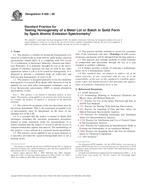1.1 This practice is suitable for testing the homogeneity of a metal lot or batch (L/B) in solid form by spark atomic emission spectrometry (Spark-AES). It is compliant with ISO Guide 35–Certification of Reference Materials: General and Statistical Principles. It is primarily intended for use in the development of reference materials but may be used in any other application where a L/B is to be tested for homogeneity. It is designed to provide a combined study of within-unit and between-unit homogeneity of such a L/B.
1.2 This practice is designed primarily to test for elemental homogeneity of a metal L/B by Spark-AES. However, it can be adapted for use with other instrumental techniques such as X-ray fluorescence spectrometry (XRF) or atomic absorption spectrometry (AAS).
Note 1 – This practice is not limited to elemental analysis or techniques. This practice can be applied to any property that can be measured, for example, the property of hardness as measured by the Rockwell technique.
1.3 The criteria for acceptance of the test specimens must be previously determined. That is, the maximum acceptable level of heterogeneity must be determined on the basis of the intended use of the L/B.
1.4 It is assumed that the analyst is trained in Spark-AES techniques including the specimen preparation procedures needed to make specimens ready for measurements. It is further assumed that the analyst is versed in and has access to computer-based data capture and analysis. The methodology of this practice is best utilized in a computer based spreadsheet.
1.5 This practice can be applied to one or more elements in a specimen provided the signal-to-background ratio is not a limiting factor.
1.6 This practice includes methods to correct for systematic drift of the instrument with time. (Warning – If drift occurs, erroneous conclusions will be obtained from the data analysis.)
1.7 This practice also includes methods to refine estimates of composition and uncertainty through the use of a type standard or multiple calibrants.
1.8 It further provides a means of reducing a nonhomogeneous set to a homogeneous subset.
1.9 This standard does not purport to address all of the safety concerns, if any, associated with its use. It is the responsibility of the user of this standard to establish appropriate safety and health practices and determine the applicability of regulatory limitations prior to use.
Product Details
- Published:
- 05/01/2008
- Number of Pages:
- 27
- File Size:
- 1 file , 260 KB
- Redline File Size:
- 2 files , 620 KB
